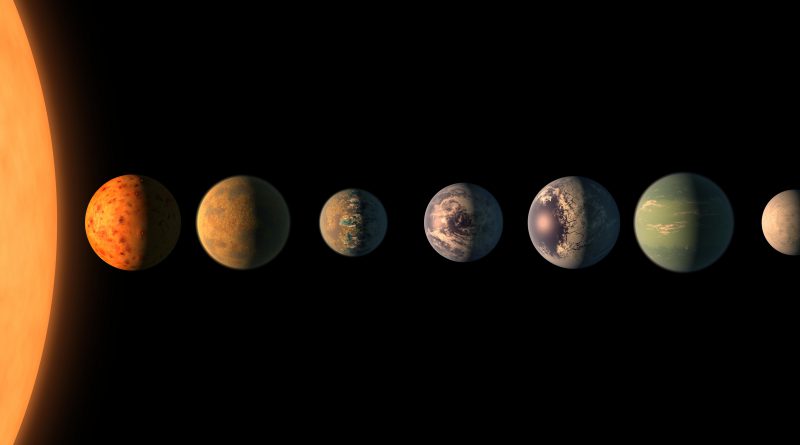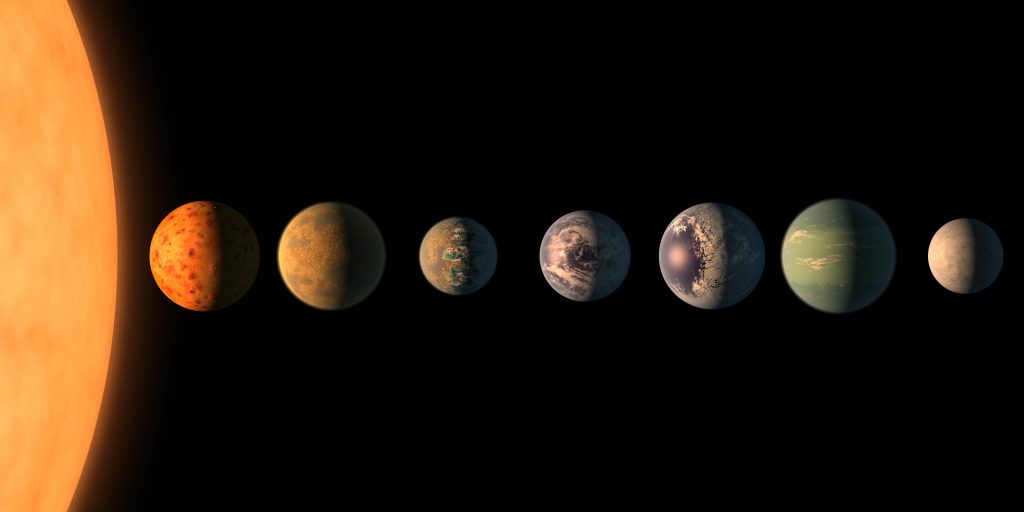Seven New Planets Discovered

NASA's Spitzer Space Telescope has revealed the first known system of seven Earth-size planets around a single star. Three of these planets are firmly located in the habitable zone, the area around the parent star where a rocky planet is most likely to have liquid water. While the NASA/JPL illustration makes the planets look tantalizing, they are beyond reach with our current spacecraft.
“This discovery could be a significant piece in the puzzle of finding habitable environments, places that are conducive to life,” said Thomas Zurbuchen, associate administrator of the agency’s Science Mission Directorate in Washington. “Answering the question ‘are we alone’ is a top science priority and finding so many planets like these for the first time in the habitable zone is a remarkable step forward toward that goal.”
At about 40 light-years (235 trillion miles) from Earth, the system of planets is relatively close to us, in the constellation Aquarius. Because they are located outside of our solar system, these planets are scientifically known as exoplanets.
This exoplanet system is called TRAPPIST-1, named for The Transiting Planets and Planetesimals Small Telescope (TRAPPIST) in Chile. The new results were published Wednesday in the journal Nature, and announced at a news briefing at NASA Headquarters in Washington.

Closer Than Mercury Means No Rotation
In contrast to our sun, the TRAPPIST-1 star – classified as an ultra-cool dwarf – is so cool that liquid water could survive on planets orbiting very close to it. All seven of the TRAPPIST-1 planetary orbits are closer to their host star than Mercury is to our sun. The planets also are very close to each other. If a person was standing on one of the planet’s surface, they could gaze up and potentially see geological features or clouds of neighboring planets, which would sometimes appear larger than the moon in Earth's sky. The planets may also be tidally locked to their star, which means the same side of the planet is always facing the star, therefore each side is either perpetual day or night. This could mean they have weather patterns totally unlike those on Earth, such as strong winds blowing from the day side to the night side, and extreme temperature changes.
44 Light-Years Is Effectively Impossible
44 light-years sounds tantalizingly close. That means the Spitzer telescope is seeing the Trappist planets as they looked in 1973. If someone on the Trappist system is looking back at us, they would be seeing Earth in 1973 - just after Apollo 17 returned from the Moon. While modern telescopes are discovering more and more habitable exoplanets, the ability to see more planets does not mean we can reach them. Using current propulsion technologies, it would take 744,186 years to reach the Trappist system. Since the universe is expanding, by the time any spacecraft would get half-way to Trappist, it would have moved another 9 light years away, adding another 167,000 years to the trip.
Breakthrough Starshot
In 2016, Yuri Miller's Breakthrough Starshot initiative set out a challenge to build an ultra-light golf ball sized probe that could travel at speeds of up to 100 million miles an hour. If such a space probe becomes reality within a generation, it would take 268 years to reach Trappist.
SpaceX Delays Mars Mission
Last week, SpaceX announced a two-year delay in their first Mars mission. Even with that delay, Mars is our best chance to become a two-planet species.

NASA/JPL offers a free series of nostalgic travel posters that you can download and print for free. Both Mars and Trappist-1e posters are available.

Stunning, full color photo book covering every east coast launch spanning 2014-2015, including the first-ever powered landing of a SpaceX Falcon 9 rocket.
More Info



